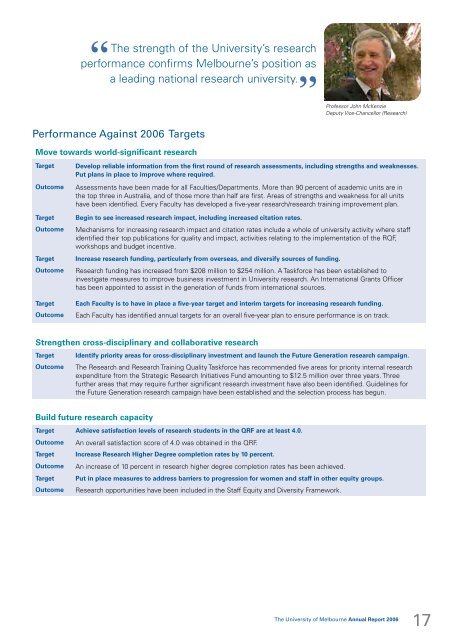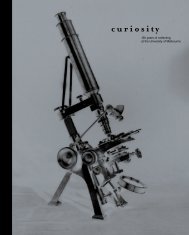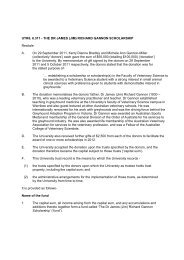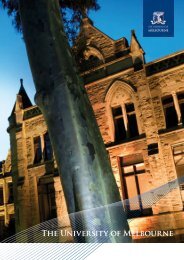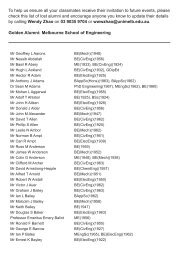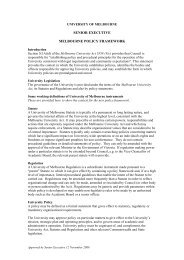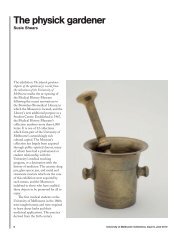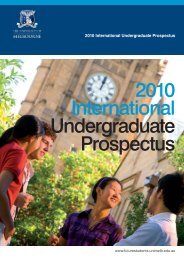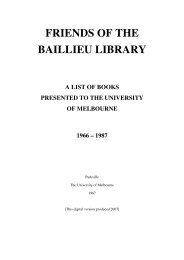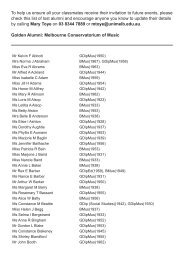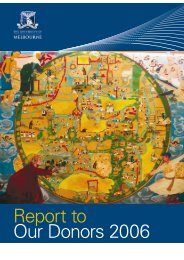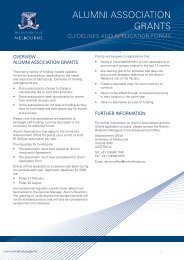annual report/2006 - University of Melbourne
annual report/2006 - University of Melbourne
annual report/2006 - University of Melbourne
Create successful ePaper yourself
Turn your PDF publications into a flip-book with our unique Google optimized e-Paper software.
The strength <strong>of</strong> the <strong>University</strong>’s research<br />
performance confirms <strong>Melbourne</strong>’s position as<br />
“a leading national research university.<br />
”<br />
Pr<strong>of</strong>essor<br />
John McKenzie<br />
Deputy Vice-Chancellor (Research)<br />
Performance Against <strong>2006</strong> Targets<br />
Move towards world-significant research<br />
Target<br />
Outcome<br />
Target<br />
Outcome<br />
Target<br />
Outcome<br />
Target<br />
Outcome<br />
Develop reliable information from the first round <strong>of</strong> research assessments, including strengths and weaknesses.<br />
Put plans in place to improve where required.<br />
Assessments have been made for all Faculties/Departments. More than 90 percent <strong>of</strong> academic units are in<br />
the top three in Australia, and <strong>of</strong> those more than half are first. Areas <strong>of</strong> strengths and weakness for all units<br />
have been identified. Every Faculty has developed a five-year research/research training improvement plan.<br />
Begin to see increased research impact, including increased citation rates.<br />
Mechanisms for increasing research impact and citation rates include a whole <strong>of</strong> university activity where staff<br />
identified their top publications for quality and impact, activities relating to the implementation <strong>of</strong> the RQF,<br />
workshops and budget incentive.<br />
Increase research funding, particularly from overseas, and diversify sources <strong>of</strong> funding.<br />
Research funding has increased from $208 million to $254 million. A Taskforce has been established to<br />
investigate measures to improve business investment in <strong>University</strong> research. An International Grants Officer<br />
has been appointed to assist in the generation <strong>of</strong> funds from international sources.<br />
Each Faculty is to have in place a five-year target and interim targets for increasing research funding.<br />
Each Faculty has identified <strong>annual</strong> targets for an overall five-year plan to ensure performance is on track.<br />
Strengthen cross-disciplinary and collaborative research<br />
Target<br />
Outcome<br />
Identify priority areas for cross-disciplinary investment and launch the Future Generation research campaign.<br />
The Research and Research Training Quality Taskforce has recommended five areas for priority internal research<br />
expenditure from the Strategic Research Initiatives Fund amounting to $12.5 million over three years. Three<br />
further areas that may require further significant research investment have also been identified. Guidelines for<br />
the Future Generation research campaign have been established and the selection process has begun.<br />
Build future research capacity<br />
Target Achieve satisfaction levels <strong>of</strong> research students in the QRF are at least 4.0.<br />
Outcome An overall satisfaction score <strong>of</strong> 4.0 was obtained in the QRF.<br />
Target Increase Research Higher Degree completion rates by 10 percent.<br />
Outcome An increase <strong>of</strong> 10 percent in research higher degree completion rates has been achieved.<br />
Target Put in place measures to address barriers to progression for women and staff in other equity groups.<br />
Outcome Research opportunities have been included in the Staff Equity and Diversity Framework.<br />
The <strong>University</strong> <strong>of</strong> <strong>Melbourne</strong> Annual Report <strong>2006</strong><br />
17


